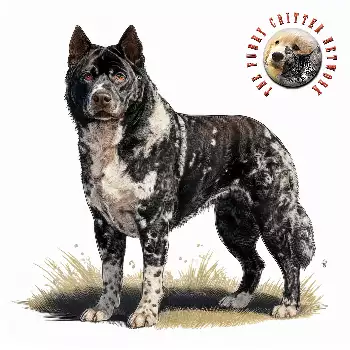Mudis are generally healthy dogs with an average lifespan of 12-14 years, though many live well into their mid-teens with proper care. The breed benefits from its working heritage and relatively small gene pool maintained by responsible breeders who prioritize health and working ability over appearance alone. Like all breeds, Mudis are susceptible to certain health conditions, and prospective owners should work with breeders who perform appropriate health testing and be prepared to partner with veterinarians throughout the dog's life.
Hip dysplasia occurs in Mudis with some frequency and should be a consideration for prospective owners. This hereditary developmental disorder affects the hip joint, causing the ball and socket to develop improperly. Over time, the malformed joint leads to arthritis, pain, and difficulty moving. Responsible breeders have breeding stock evaluated through Orthopedic Foundation for Animals (OFA) radiographs or PennHIP evaluations to identify affected individuals and make informed breeding decisions. Maintaining appropriate weight, providing joint supplements, and ensuring appropriate exercise helps manage mild to moderate cases, while severe cases may require surgical intervention.
Epilepsy affects some lines of Mudis, causing seizures that can range from mild and infrequent to severe and regular. The condition may be idiopathic (no known cause) or secondary to brain tumors, infections, or other issues. Diagnosis requires veterinary evaluation including blood work and possibly advanced imaging. Many epileptic dogs can be successfully managed with anticonvulsant medications that control seizure frequency and severity. Keeping detailed records of seizure occurrences helps veterinarians adjust medication protocols for optimal control. While epilepsy cannot be cured, most affected dogs live good quality lives with appropriate management.
Progressive Retinal Atrophy (PRA) is an inherited eye disease that can affect Mudis, causing gradual vision loss leading to blindness. Symptoms typically appear in middle age, beginning with night blindness and progressing to complete vision loss. Genetic testing is available for some forms of PRA, allowing breeders to identify carriers and make breeding decisions that prevent affected puppies. Regular eye examinations by veterinary ophthalmologists can detect early changes. While there is no treatment for PRA, affected dogs can adapt remarkably well to vision loss with patient owner support and environmental modifications.
Cataracts can develop in Mudis, causing opacity of the eye lens and potentially affecting vision. Cataracts range from small spots that don't affect vision to complete lens opacity causing blindness. The condition can be hereditary or develop secondary to diabetes, trauma, or other causes. Annual eye examinations help detect cataracts early. When cataracts significantly impair vision and quality of life, surgical removal is possible, though not all dogs are good surgical candidates. Regular veterinary eye checks help monitor any developing cataracts and guide treatment decisions.
Thyroid problems including hypothyroidism occasionally affect Mudis. This endocrine disorder occurs when the thyroid gland produces insufficient hormones, causing symptoms including weight gain, lethargy, skin problems, and hair loss. Diagnosis requires blood testing to measure thyroid hormone levels. Treatment involves daily thyroid hormone supplementation, which is generally inexpensive and effective. With appropriate medication, affected dogs live normal, healthy lives. Periodic blood tests monitor thyroid levels and allow dosage adjustments as needed.
Dental disease can affect Mudis as they age, particularly if dental care is neglected. Without regular brushing and professional cleanings, tartar builds up on teeth, leading to periodontal disease, tooth loss, and potential systemic infections affecting organs. Daily tooth brushing with dog-specific toothpaste, annual veterinary dental examinations, and professional cleanings under anesthesia when necessary maintain oral health. Starting dental care early in life establishes routine and prevents serious problems from developing.
Regular veterinary care forms the foundation of preventive health for Mudis. Annual wellness examinations allow veterinarians to detect developing problems early when treatment is most effective. Puppies require series of vaccinations to protect against infectious diseases, with booster vaccinations continued throughout life according to risk assessment and lifestyle factors. Core vaccines protect against distemper, parvovirus, hepatitis, and rabies. Additional vaccines may be recommended based on geographic location and exposure risk.
Parasite prevention is essential for maintaining Mudi health. Heartworm prevention should be administered year-round according to veterinary recommendations, as heartworm disease is serious and potentially fatal. Flea and tick prevention protects against disease transmission and parasitic infestation. Internal parasite prevention through regular fecal examinations and deworming prevents intestinal parasites. Mudis' active outdoor lifestyle means they may have higher parasite exposure than less active breeds, making prevention particularly important.
Weight management is crucial for Mudi health and longevity. Obesity exacerbates joint problems, contributes to various health issues, and reduces lifespan. Mudis should have visible waists and ribs that can be felt easily under a light layer of muscle and fat. High-quality diet appropriate for working dogs, portion control, and regular exercise maintain ideal weight. Working with your veterinarian to establish appropriate feeding guidelines ensures your Mudi maintains healthy body condition.
Spaying or neutering provides health benefits and prevents unwanted litters. Timing of sterilization surgery should be discussed with your veterinarian, as recent research suggests waiting until growth is complete may provide orthopedic benefits for some breeds. Regular dental care, appropriate preventive medicine, proper nutrition, adequate exercise, mental stimulation, and attentive monitoring for health changes help ensure Mudis live long, healthy lives as the remarkable working companions they were bred to be.
Common Health Issues
- Hip dysplasia occurs in Mudis with some frequency and should be a consideration for prospective owners.
- Epilepsy affects some lines of Mudis, causing seizures that can range from mild and infrequent to severe and regular.
- While epilepsy cannot be cured, most affected dogs live good quality lives with appropriate management.
- Thyroid problems including hypothyroidism occasionally affect Mudis.
- Dental disease can affect Mudis as they age, particularly if dental care is neglected.
Preventive Care & Health Monitoring
- Maintaining appropriate weight, providing joint supplements, and ensuring appropriate exercise helps manage mild to moderate cases, while severe cases may require surgical intervention.
- Diagnosis requires veterinary evaluation including blood work and possibly advanced imaging.
- Regular veterinary eye checks help monitor any developing cataracts and guide treatment decisions.
- Dental disease can affect Mudis as they age, particularly if dental care is neglected.
Regular veterinary check-ups and preventive care are essential for maintaining your Canis Ovilis Fenyesi's health and longevity.

